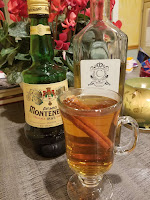In 1790, Habsburg ruler Joseph II had a bout of indigestion, and asked Dr. József Zwack, royal physician to the Imperial Court, for a remedy. Dr. Zwack offered the Holy Roman Emperor a sip of an herbal digestive and which Joseph II responded, "Das ist ein Unikum!" ("This is unique!")
I've had my share of indigestion over the years and instead of popping Gaviscon like candy or taking Omeprazole, I've decided to look at herbal remedies - and specifically - herbal liqueurs as a digestive. And there's no better place to start than Hungarian Unicom from a bottle purchased in 2001.
Fifty years after this encounter with Joseph II, József Zwack founded the J Zwack & Co., and the first herb liqueur made under the name “Unicum” and using the same recipe occurred on May 22, 1883. The round bottle contained the recognizable red circle and gold cross on its belly implying its medicinal value. As demand increased son Lajos moved the distillery to its present location in 1892. By 1926, Zwack Lajos’s sons, Béla Zwack and János Zwack had both joined the Company.
During WWII, Budapest was one of the most bombed cities in Europe, and the distillery was completely destroyed. After the war, during which the family lived in a cellar with two unexploded bombs over their heads, János and Béla, completely rebuilt the factory using the most modern technology available at the time. When, in 1948, the firm was finally ready to resume production at pre-war levels, the newly instated Communist government confiscated everything the family possessed with no compensation and "the world as I knew it", to quote Péter Zwack, János's son, "came to an end". János fled to the West with the Unicum recipe in his breast pocket, having bribed the Russian drivers to take him across the border. Béla chose to remain in Hungary and was deported, together with thousands of other "class enemies", to eke out an existence on the Great Hungarian Plain. Péter Zwack took a train to the Yugoslav border and then walked his way to Trieste where, with an overwhelming surge of joy and relief, he saw the British fleet at anchor in the bay.
When János Zwack arrived in the United States he discovered that the Communist State-run company was still exporting products to the USA under the Zwack name. He filed a court case against the importers and the government to retain the right to his family trademarks. In the end, he succeeded: in a precedent-setting ruling the State-run company was no longer allowed to use the name Unicum or Zwack in the West.
In 1988, Péter Zwack returned to Hungary and then, together with his partner, Emil Underberg of the German spirits dynasty, formed Péter Zwack und Consorten AG and later they entered into a joint venture with the State-run distillery. Four years later they founded Zwack Unicum Plc. after submitting a successful bid during the privatization process and were thus able to buy back the enterprise from the State. Obviously, my bottle was produced during the Communist management of the distillery.
Unicum is still produced using the same recipe as in 1790 which features over forty herbs. The majority of these herbs and spices come from the Carpathian basin, but ingredients are also imported from Morocco, China, India, Sri Lanka, Indonesia, Nigeria, the Americas, and Australia. The herbs are measured by hand to this day, while some special ingredients, known as the "heart” of Unicum, are personally weighed out by a family member, currently by Péter Zwack’s widow, Anne Marshall Zwack.
In order to produce Unicum, half the herbs are macerated and the others are distilled and sometimes the same herb is both macerated and distilled. During maceration, the herbs are immersed in corn alcohol, a process that provides an intensive, rich flavor, The macerated and distilled herbs are then blended together in a traditional wooden vat. The spirit is then aged in oak casks, just like the 1790 version, and today the distillery employs 500 oak casks located in cellars under the Soroksári Road distillery
And Unicom is complex. I got citrus, sweet orange rind, and pine notes on the nose. The palate is bitter, then turns a little sweet with licorice, ginger, and lemongrass notes. The finish is long, Very long. So far, no need for Gaviscon. Cheers.








